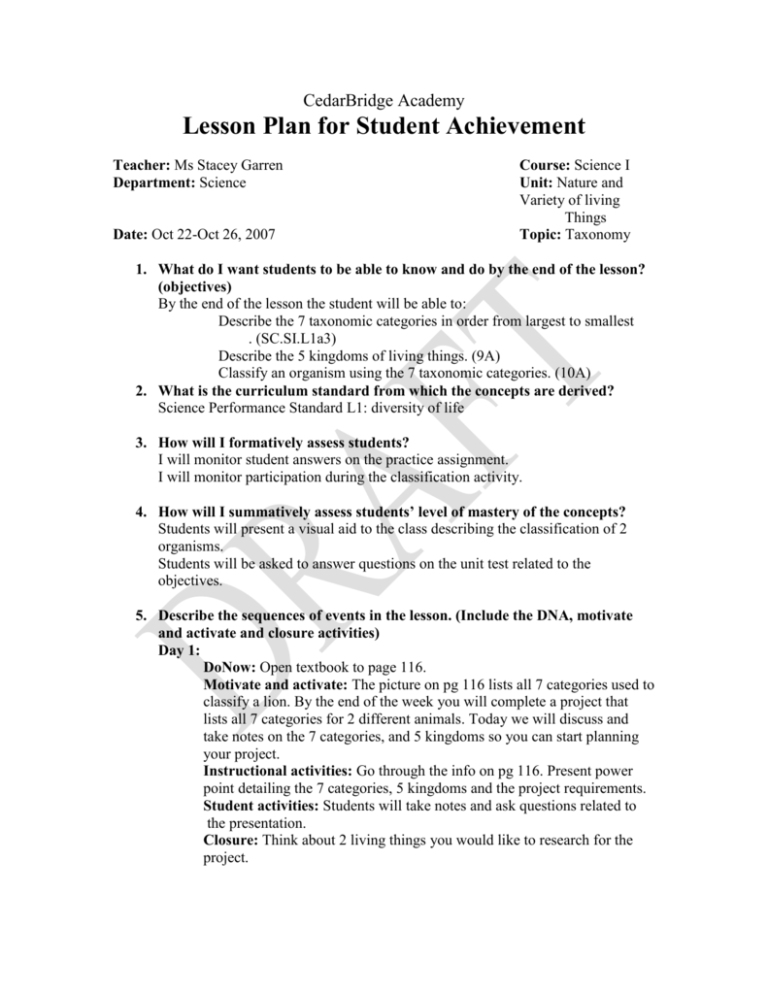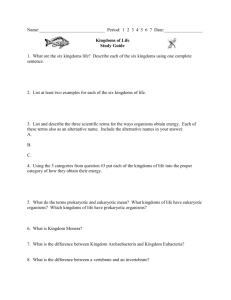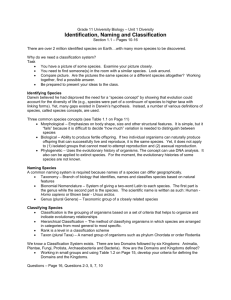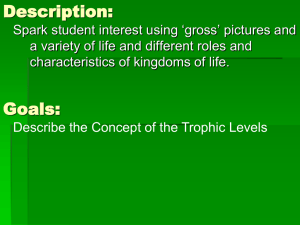Garren_NVLT Taxonomy lesson plan
advertisement

CedarBridge Academy Lesson Plan for Student Achievement Teacher: Ms Stacey Garren Department: Science Date: Oct 22-Oct 26, 2007 Course: Science I Unit: Nature and Variety of living Things Topic: Taxonomy 1. What do I want students to be able to know and do by the end of the lesson? (objectives) By the end of the lesson the student will be able to: Describe the 7 taxonomic categories in order from largest to smallest . (SC.SI.L1a3) Describe the 5 kingdoms of living things. (9A) Classify an organism using the 7 taxonomic categories. (10A) 2. What is the curriculum standard from which the concepts are derived? Science Performance Standard L1: diversity of life 3. How will I formatively assess students? I will monitor student answers on the practice assignment. I will monitor participation during the classification activity. 4. How will I summatively assess students’ level of mastery of the concepts? Students will present a visual aid to the class describing the classification of 2 organisms. Students will be asked to answer questions on the unit test related to the objectives. 5. Describe the sequences of events in the lesson. (Include the DNA, motivate and activate and closure activities) Day 1: DoNow: Open textbook to page 116. Motivate and activate: The picture on pg 116 lists all 7 categories used to classify a lion. By the end of the week you will complete a project that lists all 7 categories for 2 different animals. Today we will discuss and take notes on the 7 categories, and 5 kingdoms so you can start planning your project. Instructional activities: Go through the info on pg 116. Present power point detailing the 7 categories, 5 kingdoms and the project requirements. Student activities: Students will take notes and ask questions related to the presentation. Closure: Think about 2 living things you would like to research for the project. Day 2: DoNow: open your notebook to the notes on the 5 kingdoms Motivate and activate: Show an exemplar for their project, have them choose 2 kingdoms for their project Instructional activities: Facilitate classification activity, give instructions for worksheet Student activities: Students will work in pairs to classify cards with pictures of animals from the Galapagos into different kingdoms and then smaller and smaller categories. Students will also complete a worksheet about the characteristics of the kingdoms. Closure: Sign up for your 2 organisms Day 3: DoNow: Write down the 2 organisms you plan to research. Motivate and activate: We will be using class time to work on your classification projects. Instructional activities: answer questions, monitor computer use. Student activities: Use the internet and biology textbooks http://www.seaworld.org/animal-info/animal-bytes/index.htm to find information about members of the animal kingdom. Use http://plants.usda.gov/classification.html to find out about members of the plant kingdom. Use Microsoft publisher / word / power point to create your brochure/poster. Closure: What do you still need to be able to complete your project? Day 4: DoNow: Prepare for your presentation Motivate and activate: N/A Instructional activities: monitor presentations Student activities: Students will present the classification info for their 2 organisms. Closure: Get all of your notes/papers from unit #1 together. 6. What homework assignment will I give to students? Students will be asked to complete any work not completed during class time for homework. 7. If a colleague were observing my class to give me ideas for improving the teaching of this lesson, what would I want him/her to focus on during the observation? It would be very helpful for a colleague to provide feedback on my procedures for checking completed assignments quickly and suggestions for activities for the faster students to do while the others are finishing.









